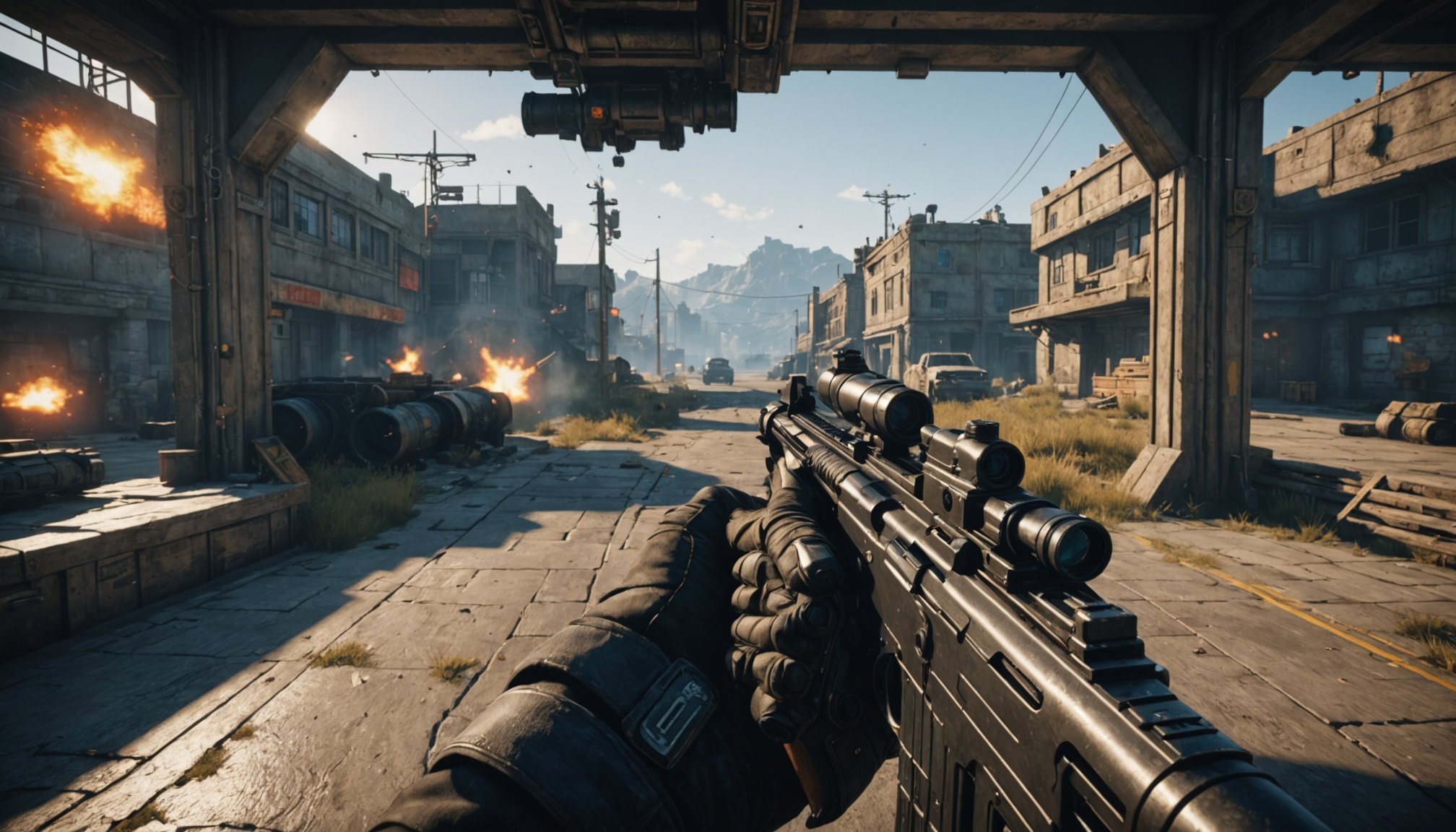Understanding HUDs in FPS Games
First-person shooter (FPS) games often rely heavily on HUD design to create an engaging and immersive user experience. But what exactly are HUDs? A Heads-Up Display, or HUD, is an essential interface that provides critical information directly in the player’s line of sight. HUD design’s importance in FPS games cannot be overstated; it serves as the player’s guide, delivering real-time updates without disrupting the immersion.
Key aspects of a well-designed HUD in FPS games involve balance and clarity. A thoughtful HUD design enhances player skills by offering critical data like health status, ammo count, and mini-maps. For example, displaying this information in a non-intrusive yet easily accessible way can significantly affect the player’s performance and engagement.
Also read : Top Techniques to Reduce Input Lag in Competitive Console Gaming for Optimal Performance
An effective HUD in FPS games typically includes:
- Health indicator: Highlights player vitality for immediate attention.
- Ammo counter: Shows remaining ammunition, crucial for strategy.
- Mini-map: Provides spatial awareness without breaking immersion.
HUDs are designed with player needs in mind, offering a blend of user experience and gameplay mechanics. They serve the dual purpose of conveying necessary information while enabling a seamless gaming experience, ultimately enriching player interaction with the game world.
Also read : Essential Safety Tips for Using Virtual Reality in Mental Health Therapy Games
Key Design Principles for HUDs
Designing an effective HUD requires careful consideration of several key principles. An intuitive layout is crucial, ensuring players can easily absorb information without being overwhelmed. This involves structuring elements in a logical manner, so users can locate important data rapidly. This not only aids usability but also enhances the overall experience by reducing cognitive load.
Balancing information density with readability is another significant aspect. While it’s tempting to display a multitude of details, overcrowding the screen can diminish usability by complicating information retrieval. A well-thought-out balance ensures that essential information is visibly accessible, while less critical data remains unobtrusive until needed. This can be achieved by prioritizing content hierarchy, employing contrasting sizes, and utilizing sharp text and visual elements.
Furthermore, accommodating diverse player preferences is paramount. Players have unique interaction styles and aesthetic tastes. By incorporating customizable options, such as adjustable layouts or the ability to alter colour schemes, developers can enhance user satisfaction. Consider scenarios where players prefer a minimalist interface versus those who thrive with comprehensive data at their fingertips. Adapting to these preferences not only caters to usability across different gameplay styles but also promotes inclusivity in gaming experiences.
Readability and Information Hierarchy
In the realm of content creation, ensuring readability and a well-structured information hierarchy are crucial components for enhancing user engagement. Prioritizing critical information is fundamental. By strategically organizing content, readers can easily identify and focus on the most important details. This often involves placing key messages at the beginning of a section to maximize impact and clarity.
The use of typography and font size plays a significant role in readability. Selecting a clear, legible font for body text alongside varying font sizes for headings assists in distinguishing between different levels of information. Large, bold headings can help to draw attention and provide structure, while smaller, consistent fonts in the main body text support ease of reading.
Visual cues, such as colours and spacing, direct the reader’s attention and facilitate smoother navigation through the text. These cues act like signposts, gently guiding readers to follow a narrative or locate essential information quickly. Ultimately, these strategies not only enhance the consumption of content but also elevate the overall engagement by making information accessible and inviting to explore.
Color Schemes and Visual Design
Understanding the importance of color schemes and visual design in gaming environments is crucial. The right combination can significantly enhance both gameplay experience and aesthetic appeal.
When selecting color palettes, it is vital to consider visibility. High-contrast color schemes ensure that crucial information is easily discernible. For instance, using a bright color like yellow against a dark background can improve the readability of in-game stats or alerts.
Psychological impact is another key aspect to consider. Colors can influence player emotions and decision-making. For example, red is often used to indicate danger or urgency, while green can represent safety or success. Recognizing these psychological effects can help in crafting a more engaging and intuitive gaming experience.
There are numerous examples of successful HUD color schemes in popular FPS games. Titles like “Call of Duty” and “Fortnite” employ cohesive designs that balance aesthetic appeal with functionality. These games often use a combination of cool and warm tones to guide players’ attention towards mission-critical elements without overwhelming them. By prioritising the best practices in these areas, game designers can create immersive environments that resonate with players.
Player Engagement and Feedback Mechanisms
Player engagement is significantly enhanced through real-time feedback. This ensures players remain motivated and informed during gameplay. Feedback mechanisms, when designed effectively, bolster the player’s interest by providing immediate results or insights into their actions.
A crucial element in designing these feedback mechanisms is maintaining balance. This involves integrating the system within the game’s environment to prevent distractions. Effective feedback should never detract from the main gameplay, ensuring seamless interaction. Too much information can overwhelm, whereas too little might leave players lost or confused.
User interaction is a core component where real-time feedback facilitates an immersive experience. When players actively interact with elements around them, well-timed feedback can enhance their understanding and enjoyment.
Case studies reveal methods for successful player engagement through Heads-Up Displays (HUDs). For instance, some use subtle visual cues, while others incorporate auditory signals to convey important information. These strategies highlight the importance of a thoughtful design that intuitively guides the player without breaking their immersion.
In conclusion, feedback mechanisms are indispensable in creating a rewarding and engaging player experience, ensuring that users remain connected and invested in the game narrative.
Testing and Iteration in HUD Design
Creating an effective HUD (Head-Up Display) involves intense testing and careful iteration. User testing forms the backbone of this process. It typically begins with controlled environments where selected users interact with the HUD. The objective is to capture valuable feedback, focusing primarily on usability and player experience.
Iteration in design improvement is crucial to refining HUD elements. It’s a cyclic process where developers incorporate feedback, tweak design elements, re-test, and gather more feedback. This loop helps address any stumbling blocks users may encounter and enhances the overall user interaction.
For example, a game developer might notice players miss crucial information displayed in the corner of the screen during user testing. In response, they might iterate by relocating this information to a more centralized area, ensuring better visibility and accessibility.
Iterations often lead to significant design revisions that better adhere to user preferences and requirements. As a result, refining HUD components becomes a collaborative journey between designers and users. This ongoing design improvement process not only hones the HUD but also enriches the user’s experience, reinforcing the importance of continuous testing and iteration.
Case Studies and Best Practices
Examining successful HUD implementations in FPS games reveals several industry examples highlighting effective design. Games like “Call of Duty” and “Battlefield” have mastered the art of crafting user-centric HUDs, maintaining clarity even in high-intensity scenarios. These games ensure crucial game information is easily accessible without obstructing the player’s view, enhancing the overall gaming experience.
On the flip side, some games have faced criticism due to ineffective HUD designs. These designs often suffer from overloading information, overwhelming players, or placing key details out of easy reach. Lessons learned include the importance of simplicity and intuitiveness; cluttered or confusing HUDs can detrimentally influence player engagement and satisfaction.
Expert opinions suggest that future trends in HUD design for FPS games will likely involve more customization options for players. This approach supports varied player preferences, allowing for better personalization and improved engagement. Moreover, with advancements in VR and AR technologies, the integration of these elements into traditional HUDs is a growing area of interest, potentially revolutionizing the way players interact with games. These insights into case studies and best practices offer valuable guidance for developers aiming to refine their HUD designs.











